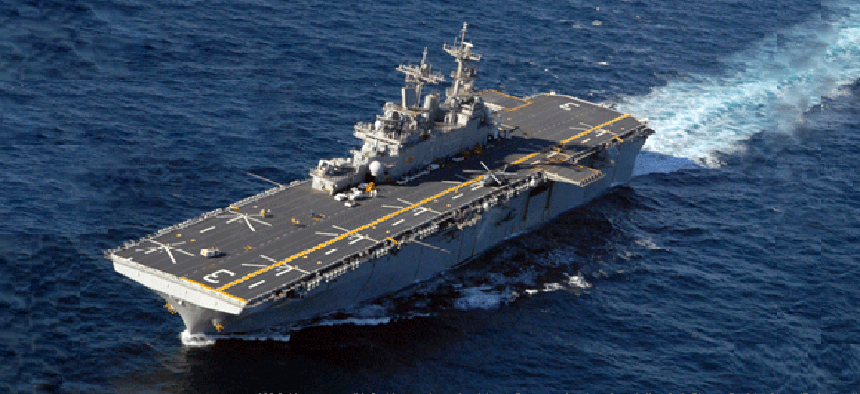Navy's ship-to-ship communications go 4G


Connecting state and local government leaders
The Naval Air Systems Command is testing an LTE network for high-bandwidth ship-to-ship communications.
Navies have had methods of intrafleet communications ever since the idea of vessels fighting as a unified force emerged. Early on messages were conveyed via a system of flag signals, then flashing lights. With the advent of radio, wireless communication was enlisted.
As time went on, the amount of information that could be relayed (the bandwidth) increased, but it fell behind commercial networks. As cellular phones and other mobile devices became popular, new commercial networks cropped up, and before long publically available bandwidth vastly outstripped what most of the military had available.
For the U.S. Navy, this has been an exceptional hurdle to overcome. And it’s not just bandwidth; there are the security concerns that every branch of the military has when using a publically accessed cellular network. The Navy also faces the additional obstacle of not-surprisingly few cell towers in waters where the large warships are on maneuvers. When there is nothing above the surface of the water but the ships, the ships themselves have to be turned into the necessary relay points.
That is exactly what the Naval Air Systems Command (NAVAIR) is in the process of doing. The command has been testing a pilot program in which two ships, the USS Kearsarge and the USS San Antonio, were equipped with a microwave-based wireless wide-area network (WWAN) to augment existing satellite-based communications. The Long-Term Evolution (LTE) network lets personnel on the two ships receive real-time video streaming from air nodes mounted on helicopters, which in turn allows officers to make quicker and more accurate decisions based on what advance units are doing.
“LTE allows the NAVY to leverage all of the advantages of smart phones and commercial broadband,” said Larry Hollingsworth, NAVAIR national director for avionics R&D. “NAVAIR is trying to address a critical requirement for the VBSS [visit, board, search and seizure] mission, but in addition the sailors are already finding the network useful in their day-to-day work. This makes common sense, since as we all use smart-phone technology in our personal lives, it is not unsurprising that the sailors would extend that utility to their work.”
Testing the network also is fairly inexpensive, Hollingsworth said, “as we are riding the coattail of cellular commercial R&D investments.”
LTE, usually referred to as 4G LTE, is a standard for high-speed communications among mobile devices, and transmits data at around 100 megabits/sec, fast enough to handle images and videos as well as voice and text. (The official LTE specification designates downlink peak rates of 300 megabits/sec and uplink peak rates of 75 megabits/sec.) In 2012, police in Florida tested a dedicated LTE network to handle security during the Republican National Convention. Emergency response teams in the Denver area also are using LTE for a public safety network.
NAVAIR selected Oceus Networks for the pilot because of its experience with 4G communications. “At the beginning of the program,” Hollingsworth said, “Oceus Networks had several things going for it.” It was the only U.S. equipment provider that had passed MIL-STD 461 Electromagnetic Interference (EMI) testing, and it is set to complete Joint Interoperability Test Command (JITC) testing to gain connections to government networks. The company also packaged its products “in a scalable architecture from a transit case to a backpack-sized family of solutions,” he said.
Oceus Networks CEO Doug Smith said the company’s R&D team has been working to modify 4G technologies into smaller, lighter form factors. The “LTE technology that most commercial providers now offer brings tremendous capabilities,” he said.
Having the ability to get high-definition video from remote sensors at the front lines quite simply can save lives. With the WWAN in place, the sailors and Marines who are equipped with Android-based smart phones can have access to voice, text and video communications between ships and remote sensors aboard the helicopters up to 20 nautical miles away.
Now that the final phase of testing is complete, the Navy plans to take the two ships to the Persian Gulf to help with anti-piracy efforts there. “The air node will allow them to have a mobile air network. We want to test that for anti-piracy missions,” said Doug Abbotts, a spokesman for NAVAIR. “The air node in the helicopter goes over the suspected pirate and the people who are advancing on the pirates, so they can shoot video through sensors. That video can be transferred to the ship via the network or transmitted to a patrol boat responding to a pirate attack.”
Whether the implementation as it currently stands will be used by the rest of the Navy’s ships remains to be seen. Even though testing is officially complete, the truth is the final test is its performance in the course of live operations.
“The Navy is looking at the value of the capability, and, while it is very promising, it is too early to say how quickly this will be fielded,” Hollingsworth said. “NAVAIR's goal was to prove that overlaying LTE on the Navy's tactical and operational architecture was feasible and that LTE is viable in the shipboard environment.”
NEXT STORY: Government isn't a game, except when it is




